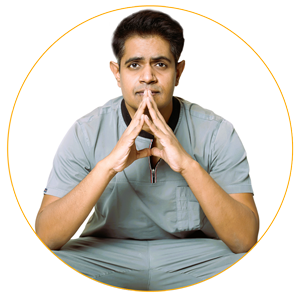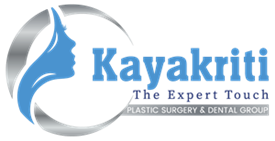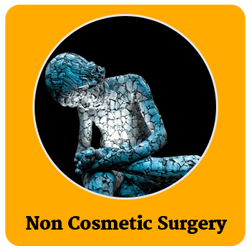Face Trauma
Facial Injury, Facial Fracture
Maxillofacial or face trauma is the name given to all the injuries to face involving minor conditions like lacerations.

Maxillofacial or face trauma is the name given to all the injuries to face involving minor conditions like lacerations and bruises to major injuries like fractures of the facial bones such as nasal fractures and fractures of the jaw, as well as injuries around the eye.
Patient suffers problems like pain, swelling, bleeding, loss of normal shape of face, blindness or difficulty moving the jaws, sometimes it can be life threatening too. If someone suffers severe facial injury, it is a high chance of possibility that he has suffered other injuries too and therefore, it becomes mandatory to rule out all possible injuries like head injury, chest injury and injury to abdominal organs.
Major causes of facial trauma includes interpersonal violence androad accidents. Strict following of traffic safety rules such as wearing seat belts in car and motorcycle helmets, avoiding drunk and unsafe drivingcan save many people from suffering these kind of injuries. Other causes can be fall from height, industrial accidents, and sports injuries.
Patient with maxillofacial trauma suffer with one or more of the following symptoms:
- Pain, bruising, and swelling of the surrounding area
- Profuse bleeding
- External deformity
- Depressed cheekbone
- Teeth alignment is lost with pain and difficulty opening their mouths
- Numbness of the cheek, lip or chin.
Dr Amit Agarwal confirm the exact site of fracture of bones of face by doing 3D CT Scan of face along with CT Scan of head done to rule out any head injury. Treatment involves basic trauma management and then cure of specific trauma of the face.
- Making sure that patient is able to breathe, if there is difficulty in breathing, it will be the first step in management
- Material may be present in the mouth that may block the airway should be removed
- Oxygen, if required
- Tracheal or nasal intubation (inserting a tube into the airway to assist breathing)
- If intubation is not possible, surgical airway has to be made in emergency by making hole in the neck (tracheostomy)
- Dressing of wounds
- Antibiotics
- Tetanus immunisation
- Open wounds suturing to stop bleeding
- Nasal packing to control nose bleeds
- Ice fomentation and pain killer
Soft tissue injuries of face
Facial skin and soft tissue injury occurs usually in association with or without facial fractures. Simple abrasions need only topical treatment.
- If there is lacerated wound which means skin margins are torn apart, stitching of the wound is done.
- But sometimes, there's loss of a portion of skin or soft tissue which if small, can be repaired primarily by stitching,
- But if it is a large gap, then various local skin flaps are used to fill the defect.
Face has different properties of skin in different areas, for example, cheeks, lips and eyelids skin is very lax and can be stretched whereas, the skin of scalp, forehead and nose lacks the laxity and can only be repaired by using local flaps in case of large skin defects. These flaps are able to cover the skin defect leaving a stitch line on the area from where they are raised initially.
Selection of skin flaps for different areas of face is different because of this property.
Nose defect
- For upper half to one-third of nose, the skin from forehead can be used to provide cover like dorsal nasal flap, glabellar flap, V-Y advancement.

- For defects which are large enough so that above mentioned flaps are not sufficient for their coverage, like skin loss of complete nose or more than two thirds of it, a different approach is used called Forehead flap. This is a larger flap used raised from the forehead and anterior part of the scalp and can be used to cover the defects upto as low as tip of nose or the nostril.
- For the defects which are along the lower portion of the nose like only nose tip or nostril, Nasolabial flap, Bilobed flap make a good option.

- If there is loss of columella, composite graft (skin and cartilage) or simply skin graft is used as per the availability of local tissues.
Cheek defect
Provided the laxity of skin of cheeks is good, small to medium sized defects can be closed by primary stitching. Only larger gaps need to be covered by flaps, flaps used for cheek defects are V-Y advancement flaps, banner flaps, limberg flaps, dufourmental flap.

Scalp defect
Since the skin of scalp is comparatively tighter than rest of the head and face, the selection of flaps is also different and larger flaps are required to be used for small defects also. Few examples are bilateral advancement flap, rotation flap, orticochea flap, etc.

Eyebrow defect
O to Z flap provide a good symmetry as required for eyebrow defect cover.

Eyelid defect and lip defect
The defect over eyelid and lip can be closed primarily if less than one third of whole length. If more than that flap from the other eyelid or lip can be taken to fill the defect Abbe flap.

Know your surgeon better

Best plastic surgeon, Dr. Amit Agarwal is an American Board Certified, extensively trained, and best Plastic & Aesthetic surgeon in Lucknow. He is the Chief Plastic Surgeon heading the Department of Plastic, Microvascular, and Craniofacial surgery at Vivekananda Polyclinic and Institute of Medical Sciences, Lucknow, U.P, India. He maintains a busy practice at Avadh and Nishat Hospital and his own center - Kayakriti Plastic Surgery & Dental Center. He was formerly a Consultant in the Department of Plastic Surgery and Burns at the prestigious SGPGI, Lucknow.
MS, DNB (General Surgery) MCh, DNB (Plastic Surgery),
MNAMS, FACS, FICS, FRCS (Edinburgh, UK)
His Credentials
Three pillars of kayakriti
Privacy
We believe your experience with us should be comfortable and hassle-free to make it one of your best lifetime experiences for yours. We, here at the clinic, take full precautions to maintain your privacy in any manner. We also provide a staff who will receive you from the gate and take you to the chamber directly if you demand.
Trust
Our Surgeon is highly qualified and internationally certified with a team of skilled staff to perform any surgical or non-surgical treatment on your body.
Safety
When you plan to undergo any surgery you should always keep in mind that it's your body and it's a surgery. We, here always keep your safety a priority and will never recommend you to undergo any such procedure which is not safe for you. We also provide you with a detailed description of the complications which may occur after the surgery during the consultation as it's a surgical procedure so there may be some complications depending on the way your body reacts.
Kayakriti in news



Frequently Asked Questions
If you have flat or small breast and you want to improve your breast and hip contour ratio then you are a good candidate for it. The answer will be best provided after the first consultation with Dr Amit Agarwal.
Acute pain will be there for almost a week which gradually reduces and there will be soreness and swelling which may take up to 3 weeks to subside.
You can join your work and daily routines after a week of the procedure and can start exercising after 3 weeks of it.
Yes, you have to wear it round the clock unless we suggest you to remove it.
This surgery does not affect the ducts or the areas of the breast involved in milk production. Thus, it does not affect the breast feeding.
This surgery does not affect the ducts or the areas of the breast involved in milk production. Thus, it does not affect the breast feeding.












Kayakriti Plastic Surgery & Dental Center
D-43, Near Punjab National Bank, Rajajipuram, Lucknow, Uttar Pradesh - 226017, India
Phone No. +919695940009, +919695940006
Map Location





























Social Media Presence